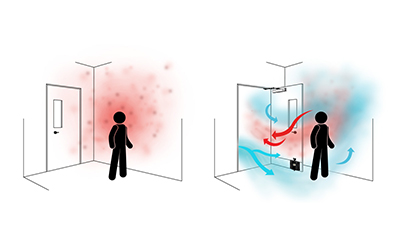In the Government press conference on the 22nd February, it was announced that all schools will reopen on the 8th March, and depending on how successful this is in keeping infection cases down, will determine whether we move to the next stage of lockdown easing. During that press conference, Sir Patrick Vallance reiterated that good ventilation in schools is vital for staying Covid-secure;
“ In schools, ventilation is going to be important as children go back, good ventilation. Masks will add to the protection, and hand washing and good hand hygiene adds to the protection ”
Why is good ventilation in schools so important?
To understand how ventilation helps, there have been many studies and articles explaining this.
The Government’s ‘Hands, Face, Space’ campaign stated that Coronavirus particles will remain in the air for much longer than Coronavirus droplets as they are far smaller and lighter. Recent research led by the University of Cambridge with Imperial College London, researchers found that:
“In poorly ventilated spaces, the virus behind COVID-19 can spread further than two metres in seconds, and is far more likely to spread through prolonged talking than through coughing”.
In October 2020, Spanish Newspaper El PaÍs published an insightful article; “A room, a bar and a classroom: how the coronavirus is spread through the air”, which examined how transmission varies in these different environments depending on the precautions in place. Inside a classroom of 24 students with a teacher who has Covid-19 (and no counter-measures being taken), up to 12 students could become infected within 2hrs. This reduces to 5 students when face masks are used. When ventilation is introduced the risk drops dramatically to one person or less. The importance that ventilation plays in reducing the spread of Covid transmission was promoted equally in all scenarios. All included opening doors as well as windows as part of ventilation measures.
Good airflow can protect against the asymptomatic
In November, the not-for-profit media website The Conversation published an article written by Shelly Miller, the Professor of Mechanical Engineering at the University of Colorado in Boulder, where she wrote on how keeping indoor air clean can reduce the chance of spreading coronavirus. She reminds us that 40% of cases are asymptomatic, which can help explain how a teacher can end up addressing a classroom when no countermeasures against the virus are taken. Her guidance on airflow in the home states:
“A typical air exchange rate for a home is around 0.5 air changes per hour. Because of the complicated way air moves, that translates into taking about two hours to replace two-thirds of the air inside an average home, and about six hours to replace all of it …//… In a pandemic this should be higher, and the World Health Organization recently recommended six air changes per hour”.
All of this is supported by The Hands, Face, Space campaign which said:
“Research shows that being in a room with fresh air can reduce the risk of infection from particles by over 70%”.
What does Government guidance say?
With Councils and the Health & Safety Executive having further powers to shut premises for not being Covid-secure, it is important to take all necessary precautions to comply with Government and public expectations. The Department of Education’s ‘Higher education: operational guidance’ makes it clear about what is expected from educational establishments in regards to ventilation:
- You should ensure that all indoor and covered areas have good ventilation in addition to other methods of risk reduction.
- Where possible, poorly ventilated spaces should be adapted to improve ventilation or, if that is not possible, they should not be used as a teaching/learning location.
- You should consider ways to maintain and increase the supply of fresh air, for example, by opening windows and doors (excluding fire doors) – we’ll come back to this point shortly.
- Also, consider if you can improve the circulation of outside air and prevent pockets of stagnant air in occupied spaces.
- Air conditioning systems should rely on fresh rather than recycled air
With Educational Secretary Nick Gibb announcing on the 25th February that it will not be made compulsory for students to wear face coverings in class, ventilation has become even more vital in keeping transmission rates down. But with many classrooms having one entry point and that door usually being a fire door, is the Government right to be saying they cannot be held open?
Can fire doors be held open to improve ventilation?
Since 23rd March 2020 (the day of the first lockdown announcement), nearly 10,000 people have viewed Fireco’s blog “is it illegal to wedge open a fire door”. With all the pressure on businesses to be COVID-secure, people have been seeking clarification on whether this takes precedence over fire safety.
On the 15th April 2020, the Fire Industry Association (FIA) managed to get clarification from the Minister for the State for Security, the Rt Hon James Brokenshire MP, that Key Worker status applied to all fire industry employees providing essential services.
Also that month, the National Fire Chiefs Council (NFCC) released their guidance; Covid-19 – Protection – Advice to Businesses, to provide consistency for Fire and Rescue Services when issuing guidance to businesses during the COVID-19 pandemic. In the COVID-19 Protection Fire Safety FAQs they make it clear that the Regulatory Reform (Fire Safety) Order 2005 still applies and that it is “the duty of the Responsible Person to ensure risk from fire is identified and suitable measures implemented”. One key point raised was the issue of wedging fire doors:
“Q. Can we wedge open fire doors to stop people from touching handles?
A. No, fire doors are an important fire safety measure, keep fire doors closed and follow government advice on hand washing and cleansing hard surfaces. Fire doors can only be held open by automatic releasing hold-open devices specifically designed and installed for this purpose”.
Unlike the Department of Education’s ‘Higher education: operational guidance’, it is made clear that rather than using a door wedge, there are legal and compliant ways to hold open a fire door that can be used to increase ventilation and reduce touchpoints.
Keeping schools Covid-secure with Fireco
In 2020, Fireco saw unprecedented demand for its Dorgard range, as companies from all sectors saw it as the quick, easy and compliant way to satisfy both fire safety and COVID-safety requirements within their buildings. Fireco’s Dorgard range has been a market leader for retrofit fire door retainers for over 25 years and by September 2020 we had sold our millionth Dorgard. One of the reasons for this surge in demand during the pandemic is the fact that Dorgard is ready straight from the box and only takes four screws to attach to the door – a simple task for any handyman.
Every type of workplace has invested in Dorgards – ranging from primary schools & care homes to social media giants & Grand Prix teams – and this is expected to continue now that the Government has laid out the roadmap for easing restrictions. It’s been made clear that in order to have our freedom back in June, we need to keep infection rates down and increasing ventilation will be fundamental in achieving this.
Buy Dorgard today and improve ventilation to help keep your school COVID-secure.
Written by James Cox, Head of Sales UK at Fireco.






0 Comments